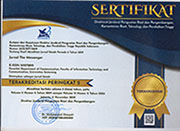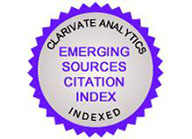Frontline Employees’ Motivation towards Customers’ Value Outcomes: A Context of Non-Fuel Retailing
Abstract
Introduction: The present study aimed to explore the frontline employees in-shop motivation to influence the customers in-shop emotions. The study further proposed the conceptual foundations of the dynamic nature of value outcomes in non-fuel retail stations, where each customer perceives the interaction with frontline employee differently. Therefore, the value outcomes based on the customers’ in-shop emotions were dynamic.
Methods: The study had used the content analysis to seek the outcome where the data was collected using open-ended interviews from frontline employees and customers of non-fuel retail outlets in Malaysia. The sample size was 12 using the snowball technique, including 6 frontline employees in phase 1 and 6 customers in phase 2 who had visited the same non-fuel retail outlets used in phase 1 for data collection.
Findings: The results showed interesting findings where it was observed that customers get positive and negative influence emotionally through individual interaction with frontline employees. Furthermore, the positive/negative emotions helped the customers to create or destroy the value individually. These service encounters are subjective and vary from customer-customer affecting their emotions differently are therefore cannot be generalized on the large set of audience.
Originality: Through the lens of S-D logic paradigm, the present study has conceptualized the dynamic nature of emotions which can lead towards value creation/value destruction or value destruction/value creation in different situations and contexts based on the individual service encounters of customers-frontline employees within non-fuel retail shops.
Keywords
Full Text:
PDFReferences
Abid, M. F., & Ahmed, M. I. (2020). Impact of employee empowerment on organizational performance with mediating role of organizational commitment. An empirical study of Telecommunication Sector of Pakistan. Foundation University Journal of Business & Economics, 5(2), 77–95. https://doi.org/https://doi.org/10.33897/fujbe.v5i2.447
Abid, M. F., Shamim, A., Khan, Z., & Khan, I. (2022). Value creation or value destruction: conceptualizing the experiential nature of value‐in‐use. Journal of Consumer Behaviour, 21(3), 583–601. https://doi.org/https://doi.org/10.1002/ cb.2033
Åkesson, M., & Skålén, P. (2011). Towards a service‐dominant professional identity: An organisational socialisation perspective. Journal of Service Management, 22(1), 23–38. https://doi.org/https://doi.org/10.1108/09564231111106901
Amin, M., Shamim, A., Ghazali, Z., & Khan, I. (2021). Employee motivation to co-create value (EMCCV): construction and validation of scale. Journal of Retailing and Consumer Services, 58, 102334. https://doi.org/https://doi.org/10.1016/j.jretconser.2020.102334
Andreu, L., Sánchez, I., & Mele, C. (2010). Value co-creation among retailers and consumers: New insights into the furniture market. Journal of Retailing and Consumer Services, 17(4), 241–250. https://doi.org/https://doi.org/10.1016/j.jretconser.2010.02.001
Ashforth, B. E., & Mael, F. (1989). Social identity theory and the organization. Academy of Management Review, 14(1), 20–39.
Awan, M. I., Shamim, A., & Ahn, J. (2021). Implementing ‘cleanliness is half of faith’in re-designing tourists, experiences and salvaging the hotel industry in Malaysia during COVID-19 pandemic. Journal of Islamic Marketing, 12(3), 543–557. https://doi.org/https://doi.org/10.1108/JIMA-08-2020-0229
Bagozzi, R. P., & Dholakia, U. (1999). Goal setting and goal striving in consumer behavior. Journal of Marketing, 63(4_suppl1), 19–32.
Blocker, C. P., & Barrios, A. (2015). The transformative value of a service experience. Journal of Service Research, 18(3), 265–283. https://doi.org/https://doi.org/10.1177/10946705155830
Bogers, M., Afuah, A., & Bastian, B. (2010). Users as innovators: A review, critique, and future research directions. Journal of Management, 36(4), 857–875. https://doi.org/https://doi.org/10.1177/014920630935394
Burns, D. J., & Neisner, L. (2006). Customer satisfaction in a retail setting: The contribution of emotion. International Journal of Retail & Distribution Management, 34(1), 49–66. https://doi.org/https://doi.org/10.1108/09590550610642819
Dawson, S., Bloch, P. H., & Ridgway, N. (1990). Shopping motives, emotional states, and. Journal of Retailing, 66(4), 408–427.
Ellsworth, P. C. (1994). Sense, culture, and sensibility.
Ellway, B. P. W., & Dean, A. M. (2016). The reciprocal intertwining of practice and experience in value creation. Marketing Theory, 16(3), 299–324. https://doi.org/https://doi.org/10.1177/1470593116636088
Etgar, M. (2008). A descriptive model of the consumer co-production process. Journal of the Academy of Marketing Science, 36, 97–108. https://doi.org/DO:I10.1007/s11747-007-0061-1
Fedorenko, I., & Berthon, P. (2017). Beyond the expected benefits: unpacking value co-creation in crowdsourcing business models. AMS Review, 7, 183–194. https://doi.org/https://doi.org/10.1007/s13162-017-0106-7
Gibbs, G. R. (2007). Thematic coding and categorizing. Analyzing Qualitative Data, 703, 38–56. https://doi.org/https://dx.doi.org/10.4135/9781849208574
Graham, J. R., Harvey, C. R., & Rajgopal, S. (2006). Value destruction and financial reporting decisions. Financial Analysts Journal, 62(6), 27–39. https://doi.org/https://doi.org/10.2469/faj.v62.n6.4351
Grönroos, C. (1984). A service quality model and its marketing implications. European Journal of Marketing, 18(4), 36–44. https://doi.org/https://doi.org/10.1108/EUM0000000004784
Grönroos, C. (2011). Value co-creation in service logic: A critical analysis. Marketing Theory, 11(3), 279–301. https://doi.org/https://doi.org/10.1177/1470593111408177
Grönroos, C. (2012). Conceptualising value co-creation: A journey to the 1970s and back to the future. Journal of Marketing Management, 28(13–14), 1520–1534. https://doi.org/https://doi.org/10.1080/0267257X.2012.737357
Grönroos, C. (2017). On value and value creation in service: a management perspective. Journal of Creating Value, 3(2), 125–141. https://doi.org/https://doi.org/10.1177/2394964317727196
Grönroos, C., & Voima, P. (2013). Critical service logic: making sense of value creation and co-creation. Journal of the Academy of Marketing Science, 41, 133–150. https://doi.org/https://doi.org/10.1007/s11747-012-0308-3
Gummerus, J. (2013). Value creation processes and value outcomes in marketing theory: strangers or siblings? Marketing Theory, 13(1), 19–46. https://doi.org/https://doi.org/10.1177/1470593112467267
Hoyer, W. D., Chandy, R., Dorotic, M., Krafft, M., & Singh, S. S. (2010). Consumer cocreation in new product development. Journal of Service Research, 13(3), 283–296. https://doi.org/https://doi.org/10.1177/1094670510375604
Hussain, A., Abbasi, A. Z., Hollebeek, L. D., Schultz, C. D., Ting, D. H., & Wilson, B. (2022). Videogames-as-a-service: converting freemium-to paying-users through pop-up advertisement value. Journal of Services Marketing, 36(3), 398–415. https://doi.org/https://doi.org/10.1108/JSM-05-2020-0164
Hussain, A., Ting, D. H., & Mazhar, M. (2022). Driving consumer value co-creation and purchase intention by social media advertising value. Frontiers in Psychology, 13, 800206. https://doi.org/https://doi.org/10.3389/fpsyg.2022.800206
Ind, N., Fuller, C., & Trevail, C. (2012). Brand together: How co-creation generates innovation and re-energizes brands. Kogan Page Publishers.
Jan, A. A., Lai, F.-W., & Tahir, M. (2021). Developing an Islamic Corporate Governance framework to examine sustainability performance in Islamic Banks and Financial Institutions. Journal of Cleaner Production, 315, 128099. https://doi.org/https://doi.org/10.1016/j.jclepro.2021.128099
Kishore, K., & Patel, R. P. (2012). Role of non-fuel retailing services: the face of petro-retailing in India. Journal of Business and Retail Management Research, 7(1), 48–59.
Laud, G., Bove, L., Ranaweera, C., Leo, W. W. C., Sweeney, J., & Smith, S. (2019). Value co-destruction: a typology of resource misintegration manifestations. Journal of Services Marketing, 33(7), 866–889. https://doi.org/https://doi.org/10.1108/JSM-01-2019-0022
Leo, C., & Zainuddin, N. (2017). Exploring value destruction in social marketing services. Journal of Social Marketing, 7(4), 405–422. https://doi.org/https://doi.org/10.1108/JSOCM-03-2017-0022
Machleit, K. A., & Mantel, S. P. (2001). Emotional response and shopping satisfaction: Moderating effects of shopper attributions. Journal of Business Research, 54(2), 97–106. https://doi.org/https://doi.org/10.1016/S0148-2963(99)00093-4
Mattila, A. S., & Enz, C. A. (2002). The role of emotions in service encounters. Journal of Service Research, 4(4), 268–277. https://doi.org/https://doi.org/10.1177/1094670502004004004
Mazhar, M., Ting, D. H., Hussain, A., Nadeem, M. A., Ali, M. A., & Tariq, U. (2022). The role of service recovery in post-purchase consumer behavior During COVID-19: a Malaysian perspective. Frontiers in Psychology, 12, 786603. https://doi.org/https://doi.org/10.3389/fpsyg.2021.786603
McColl-Kennedy, J. R., & Smith, A. K. (2006). Customer emotions in service failure and recovery encounters. Individual and Organizational Perspectives on Emotion Management and Display, 2, 237–268. https://doi.org/https://doi.org/10.1016/S1746-9791(06)02010-4
Medberg, G., & Grönroos, C. (2020). Value-in-use and service quality: do customers see a difference? Journal of Service Theory and Practice, 30(4/5), 507–529. https://doi.org/https://doi.org/10.1108/JSTP-09-2019-0207
Mustak, M., Jaakkola, E., & Halinen, A. (2013). Customer participation and value creation: a systematic review and research implications. Managing Service Quality: An International Journal, 23(4), 341–359. https://doi.org/https://doi.org/10.1108/MSQ-03-2013-0046
Pera, R., Occhiocupo, N., & Clarke, J. (2016). Motives and resources for value co-creation in a multi-stakeholder ecosystem: A managerial perspective. Journal of Business Research, 69(10), 4033–4041. https://doi.org/https://doi.org/10.1016/j.jbusres.2016.03.047
Petermans, A., Janssens, W., & Van Cleempoel, K. (2013). A holistic framework for conceptualizing customer experiences in retail environments. International Journal of Design, 7(2).
Petermans, A., Van Cleempoel, K., Nuyts, E., & Vanrie, J. (2009). Measuring emotions in customer experiences in retail store environments. International Journal of Retail and Distribution Management, 2009, 2257–2265.
Prentice, C., & King, B. (2011). The influence of emotional intelligence on the service performance of casino frontline employees. Tourism and Hospitality Research, 11(1), 49–66. https://doi.org/http://www.jstor.org/stable/23745425.
Ranjan, K. R., & Read, S. (2016). Value co-creation: concept and measurement. Journal of the Academy of Marketing Science, 44, 290–315. https://doi.org/https://doi.org/10.1007/s11747-014-0397-2
Robert, D., & John, R. (1982). Store atmosphere: an environmental psychology approach. Journal of Retailing, 58(1), 34–57.
Salomonson, N., Åberg, A., & Allwood, J. (2012). Communicative skills that support value creation: A study of B2B interactions between customers and customer service representatives. Industrial Marketing Management, 41(1), 145–155. https://doi.org/https://doi.org/10.1016/j.indmarman.2011.11.021
Sánchez-Fernández, R., & Iniesta-Bonillo, M. Á. (2007). The concept of perceived value: a systematic review of the research. Marketing Theory, 7(4), 427–451. https://doi.org/https://doi.org/10.1177/1470593107083165
Shamim, A., & Ghazali, Z. (2014). A Conceptual Model for Developing Customer Value Co-Creation Behaviour in Retailing. Global Business & Management Research, 6(3).
Shamim, A., Siddique, J., Noor, U., & Hassan, R. (2023). Co-creative service design for online businesses in post-COVID-19. Journal of Islamic Marketing, 14(1), 128–145. https://doi.org/https://doi.org/10.1108/JIMA-08-2020-0257
Siddique, J., Shamim, A., Nawaz, M., Faye, I., & Rehman, M. (2021). Co-creation or co-destruction: a perspective of online customer engagement valence. Frontiers in Psychology, 11, 591753. https://doi.org/https://doi.org/10.3389/fpsyg.2020.591753
Sugathan, P., Ranjan, K. R., & Mulky, A. G. (2017). An examination of the emotions that follow a failure of co-creation. Journal of Business Research, 78, 43–52. https://doi.org/https://doi.org/10.1016/j.jbusres.2017.04.022
Syam, N. B., & Pazgal, A. (2013). Co-creation with production externalities. Marketing Science, 32(5), 805–820. https://doi.org/https://doi.org/10.1287/mksc.2013.0791
Szymkowiak, A., Gaczek, P., Jeganathan, K., & Kulawik, P. (2021). The impact of emotions on shopping behavior during epidemic. What a business can do to protect customers. Journal of Consumer Behaviour, 20(1), 48–60. https://doi.org/https://doi.org/10.1002/cb.1853
Terblanche, N. S. (2018). Revisiting the supermarket in-store customer shopping experience. Journal of Retailing and Consumer Services, 40, 48–59. https://doi.org/https://doi.org/10.1016/j.jretconser.2017.09.004
Triantafillidou, A., Siomkos, G., & Papafilippaki, E. (2017). The effects of retail store characteristics on in-store leisure shopping experience. International Journal of Retail & Distribution Management, 45(10), 1034–1060. https://doi.org/https://doi.org/10.1108/IJRDM-07-2016-0121
Vargo, S. L., & Lusch, R. F. (2004). The four service marketing myths: remnants of a goods-based, manufacturing model. Journal of Service Research, 6(4), 324–335. https://doi.org/https://doi.org/10.1177/1094670503262946
Vargo, S. L., & Lusch, R. F. (2014). Inversions of service-dominant logic. Marketing Theory, 14(3), 239–248. https://doi.org/https://doi.org/10.1177/1470593114534339
Xie, C., Bagozzi, R. P., & Troye, S. V. (2008). Trying to prosume: toward a theory of consumers as co-creators of value. Journal of the Academy of Marketing Science, 36, 109–122. https://doi.org/https://doi.org/10.1007/s11747-007-0060-2
DOI: http://dx.doi.org/10.26623/themessenger.v14i2.3423
Refbacks
- There are currently no refbacks.
Copyright (c) 2022 Jurnal The Messenger
View My Stats [Jurnal The Messenger] is an International Scientific Journal, Published by the Department of Communication, Faculty of Information Technology and Communication, Universitas Semarang (Central Java, Indonesia). It is licensed under a Creative Commons Attribution 4.0 International License.



_11.jpg)




_BARCODE.jpg)
_BARCODE1.jpg)



5.png)










2.png)





